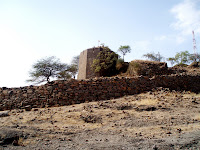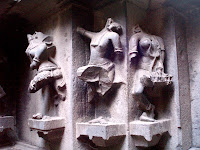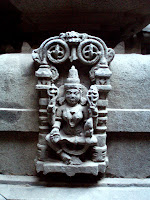Known for its exquisite sculptures, the Bhuleshwar temple, is located 10kms from Yavat village and 50kms from Pune off the Pune–Solapur highway (on Yavat-Saswad road) .
The temple was constructed sometime in the thirteenth century, Yadava period . It had a fort (which was called Daulatmangal) constructed around it . This was sometime in the 17th century , and made at the behest of the Adilshahi Hindu general, Murar Jagdev ostensibly to keep a watch over the Pune region.
There are still remnants of the fort walls and ruined bastions in the vicinity.
One also sees a dilapidated mosque outside the temple premises. It was perhaps constructed by Murar Jagdev for his muslim soldiers. Afterall Murar Jagdev was a hindu general in the service of a muslim king.
The temple also has a mythological story woven around it. It is said that Godess Parvati seduced Lord Shiva after dancing for him in this place, before both ascended to the Kailasa mountain for the matrimony.
The temple is made in two layers. The the first layer i.e the temple wall structure which is Yadav kaalin is made from black Basalt stone, while the second layer i.e the shikhara structure is made in lime and gypsum, and was constructed during the Maratha-Peshwa period (perhaps the 18th century) as is evident from the Indo Saracenic style of shikharas which were in vogue during that period.
The spires/domes belong to the ‘nagara’ style, while the original temple is distinctly 'hemadpanthi'.
The spires are made from lime and plaster and have beautiful stucco work with detailed motifs and figurines of deities,birds,reptiles and animals.
The main dome is bulbous and ribbed with a pointed finial and is surrounded by several smaller spires. A style that has been borrowed from Islamic architecture and assimilated in time with its Hindu counterpart.
The spires are made from lime and plaster and have beautiful stucco work with detailed motifs and figurines of deities,birds,reptiles and animals.
Pic: The shikhara has figurines of Vishnu, Sharabha,Ganesha,devi etc carved on them
The temple is dedicated to Lord Shiva and is accompanied by idols of Godess Parvati, Lord Ganesha,Nandi,Kali,Shakti,Vishnu,Saraswati,Laxmi besides a pantheon of other Hindu Gods and Godesses.
There are several dextrously carved sculptures of Apsaras/Surasundaris (celestial maidens) ,Gandharvas-Yakshas (demi gods), bhaarvahakas (on pillar capitals) adorning the walls of the temple.
Pic: Yakshas/ bhaarvaahakas adorning the mandi of the pillar and motif work on the malasthana,mala
There is the antarala joining the sabhamandapa with the garbhagriha or the sanctum sanctorum.
The sanctum houses the sacred Shiva linga, the phallic representation of Lord Shiva.
The sanctum houses the sacred Shiva linga, the phallic representation of Lord Shiva.
The doorframe of the garbhagriha is intricately carved and has some apsaras sculpted on either side of the frame's base.
The mandovara or the walls of the sabhamandap and gabhara are corrugated in structure and deftly sculpted with statuetes of nymphs and other celestial beings, besides several Gods and Godesses.
There are statuetes of Parvati aai, Lord Ganesha and also a daunting sculpture of Chamundi dancing over a corpse.
The other walls have stories from the hindu epics of Ramayana and the Mahabharata etched in mural form.
Three such scenes were identifiable. The first being ‘Bharat bhet’(meeting between Ram and his brother Bharat) from Ramayana or perhaps being the scene where Arjuna confers with Lord Krishna at the Kurukshetra battlefield,
the second being the scene from Mahabharata where ‘Bheeshma pitamaha is lying wounded on the battlefield on a Sharapanjari (bed of grass) created for him by the Pandavas, who are seen attending to him’ .
Also present are murals depicting dancing elephants,Vyals (mythical lion like creatures),soldiers, chariots carved on the plinth (pitha).Then there is one figurine of Arjuna piercing the fish's eye with his arrow.One gets simply enthralled while studying them in detail.
Many of the wall sections have Apsaras or nymphs dancing , dressing up, carrying a garland that resembles a snake etc and one does get enthralled watching the variety on display .
The overhead wall panels in different sections outside the sabhamandap are particularly interesting.One such panel displays figurines of Ganesha in a female form as Ganeshi / Vinayaki (identifiable because of the trunk and also by the mouse shown as the carrier) , Shiva / Maheshwari ( in a lady form,recognised by his carrier Nandi, the bull ) and a third deity, all flanked by dragon like creatures from either side . The fire emited from the dragon forms a torana like design over the deities.There are similar panels with Vishnu (carried by a eagle-human viz.Garuda) in a feminne form as Vaishnavi,Brahma or Brahmi (carried by a swan),Kartikeya- Kartikeyani/Kaumari (carried by a peacock), Indra (Indrani) carried by his elephant Airavata, Chamundi on a corpse etc.All the Gods are shown in feminine form (a part of the Sapta or Ashta matrika / 7-8 mother goddess pantheon).The ceiling around it is exposed to the sky and one can see the lime based shikhara structure with beautiful sculptings and motifs carved over them.
One also notices minor temples, one such dedicated to Lord Vitthal-Rakhumai ( Lord Vishnu and Godess Laxmi as are worshipped locally).There is also a dark room which has a figurine of Lord Vishnu with a conch resting on the coiled Sheshanaga (multi headed serpent king), besides some aedicules with idols.
The crowds seem conspicuously absent in the temple and devotees gather here mainly during Mondays and Mahashivaratri.
Tawny eagles are said to migrate here from the north during the summers and act as a added treat for the bird watchers.
The entire temple complex is surrounded by a fortified stone wall. There are also some minor temples present in the premises .
One also notices huge stone steps that leads down to a village below.
After a visit to this temple one cant help but admire the ingenuinity of this medieval architect and his team of the most adroit artisans .
Text and Photographs: Abhijit Rajadhyaksha (except the photo credited).



















































Wonderful blog,this is the great historical place in pune.Thanks for sharing the photos.
ReplyDeleteEdoubts.
This is indeed a full writeup on this mandir ( as far I can see ) well documented photo also . The writer has also taken us to see around . The remnants of the fort and masjid etc . This really completes the explanations . Great !
ReplyDeleteso nice.. and informative.
ReplyDeleteThis comment has been removed by the author.
ReplyDeleteNice post. You will be greeted by splendid architectural beauty as soon as you enter the 1100 year old Bhuleshwar Temple in Pune. The exquisite stonework and patterns inside the temple are a sight to behold. Visit this stunning temple to seek some divine intervention and admire its marvellous beauty. Check out all best places to visit in Pune also.
ReplyDeleteVery nice,informative, descriptive and near up to detail oriented, after reading this and 'भुलेश्वर मंदिर' Wikipedia, I have decided to visit the Bhuleshwar mandir as soon as possible. Thanks
ReplyDeleteI have gteat facination for Lord shri khdoba to which this Mandir belongs. Bog is very informative. Does it have trecking road to top or only some steps is not clear.Thanks for blog and images of splendid place.
ReplyDeleteI have gteat facination for Lord shri khdoba to which this Mandir belongs. Bog is very informative. Does it have trecking road to top or only some steps is not clear.Thanks for blog and images of splendid place.
ReplyDeleteGreat post about the temple and how you shared your visit experience is awesome.Thank you for posting in your blog. Bus Tickets
ReplyDeleteNice architectural place, thanks for sharing about this wonderful place in this blog. Pictures were wonderful with nice explanations. Visit this place by booking your bus tickets in advance in SRS Travels.
ReplyDelete